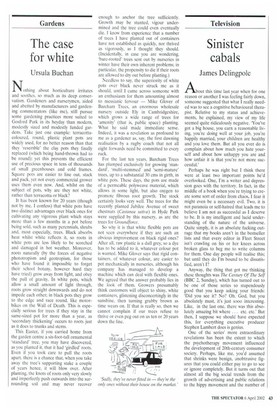The case for white
Ursula Buchan
Nothing about horticulture irritates and soothes, so much as its deep conservatism. Gardeners and nurserymen, aided and abetted by manufacturers and gardening commentators (like me), still pursue some gardening practices more suited to Gosford Park in its heyday than modern, modestly sized and modestly funded gardens. Take just one example: terracottacoloured, round, plastic plant pots are widely used, for no better reason than that they 'resemble' the clay pots they finally replaced (which being hand-thrown had to be round): yet this prevents the efficient use of precious space in tens of thousands of small greenhouses and cold frames. Square pots are easier to line out, stack and pack, yet not every commercial grower uses them even now. And, whilst on the subject of pots, why are they not white, rather than terracotta or black?
It has been known for 20 years (though not by me. I confess) that white pots have two distinct advantages over black ones for cultivating any vigorous plant which stays more than a few months in a pot before being sold, such as many perennials, shrubs and, most especially, trees. Black absorbs heat whilst white reflects it, so roots in white pots are less likely to be scorched and damaged in hot weather. Moreover, roots naturally (by the forces of negative phototropism and geotropism, for those who have found it impossible to forget their school botany, however hard they have tried) grow away from light, and obey the pull of gravity. In white pots, which allow a small amount of light through, roots grow straight downwards and do not impede each other; in black pots they grow to the edge and race round, like motorbikes on the Wall of Death. This is especially serious for trees if they stay in the same-sized pot for more than a year, as 'secondary thickening' occurs to roots just as it does to trunks and stems.
This Easter, if you carried home from the garden centre a six-foot-tall ornamental 'standard' tree, you may have discovered, as you planted it, that it had 'girdled' roots. Even if you took care to pull the roots apart, there is a chance that, when you take away the tree's supporting stake a couple of years hence, it will blow over. After planting, the knots of roots only very slowly and imperfectly push outwards into the surrounding soil and may never recover enough to anchor the tree sufficiently. Growth may be stunted, vigour undermined and the tree could even eventually die. I know from experience that a number of trees I have planted out of containers have not established as quickly, nor thrived as vigorously, as I thought they should. (Incidentally, in case you are wondering, tare-rooted' trees sent out by nurseries in winter have their own inherent problems; in particular, the propensity to die if their roots are allowed to dry out before planting.)
Needless to say, the superiority of white pots over black never struck me as it should, until I came across someone with an enthusiasm for them amounting almost to messianic fervour — Mike Glover of Barcham Trees, an enormous wholesale nursery outside Ely in Cambridgeshire, which grows a wide range of trees for 'amenity' (that is, public space) planting. What he said made immediate sense. Indeed, it was a revelation as profound to me as a gardener as, say, the first dawning realisation by a rugby coach that not all eight forwards need be committed to every ruck.
For the last ten years, Barcham Trees has plumped exclusively for growing 'standard', 'multi-stemmed' and 'semi-mature' trees, up to a substantial 30 ems in girth, in white pots. These days, the pots are made of a permeable polyweave material, which allows in some light, but also oxygen to promote fibrous root growth. The stock certainly looks very well. The trees for the recently planted Jubilee Avenue of sweet chestnuts (Castanea sativa) in Hyde Park were supplied by this nursery, as are the trees for Groundforce.
So why it is that white flexible pots are not seen everywhere if they are such an obvious improvement on black rigid ones? After all, raw plastic is a dull grey, so a dye has to be added to it, whatever colour pot is wanted. Mike Glover says that rigid containers, of whatever colour, are easier to pot mechanically in nurseries, although his company has managed to develop a machine which can deal with flexible ones. We agreed that the answer probably lies in the look of them. Growers presumably think customers will object to shiny, white containers, glistening disconcertingly in the sunshine, then turning grubby brown as time wears on. If that is really so, then we cannot complain if our trees refuse to thrive or even peg out on us ten or 20 years down the line.






























































 Previous page
Previous page